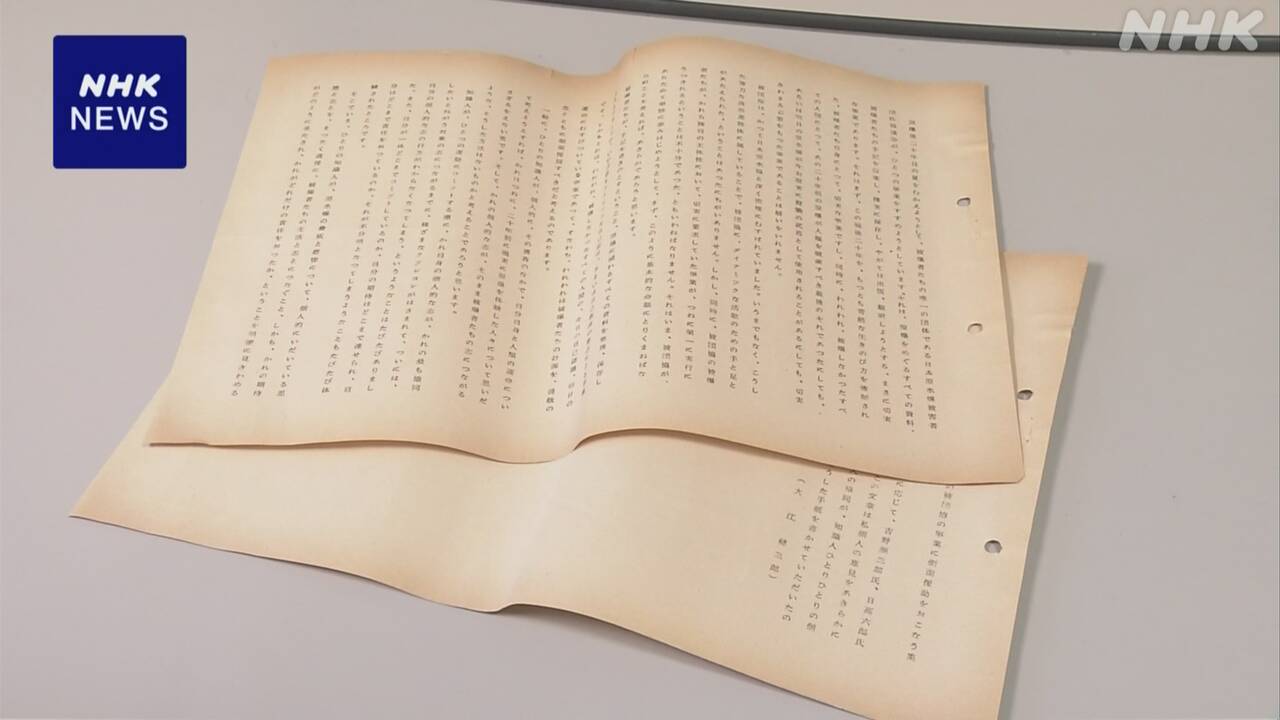In 1965, 20 years after the atomic bomb was dropped, Kenzaburo Oe, the second Japanese writer to win the Nobel Prize in Literature and who continued to spread the word about the abolition of nuclear weapons and peace, decided to collect and preserve materials such as his experiences with the atomic bomb. It has been discovered that a document was left in existence in 1995 calling for cooperation from intellectuals of the time.
Kenzaburo Oe, who passed away in March last year, published ``Hiroshima Notes'' in 1965, which depicts atomic bomb survivors and the doctors treating them, based on his research in Hiroshima. continued to communicate about the abolition and peace of Japan.
The newly discovered document was discovered among the materials collected so far by the No More Hibakusha Memory Heritage Society, which was established at the request of Mr. Oe and others.
The document was created jointly with other writers and scholars by the Nippon Hidankyo (Japan Atomic and Hydrogen Bomb Victims Association), which began collecting materials such as the experiences of atomic bomb survivors in 1965, 20 years after the atomic bombing. It was written to appeal to the intellectuals of the time for their cooperation.
In the book, Mr. Oe, who was 30 years old at the time, wrote about atomic bomb survivors talking and writing about their own experiences, saying, ``It is the most stoic form of self-proof, or a project based on the will of self-salvation.''
``If an intellectual were to think about his own fate and the fate of humanity, he would have no choice but to think about the people who actually experienced the atomic bomb twenty years ago,'' he said. We are asking for your cooperation.
The relationship between Kenzaburo Oe and the atomic bomb survivor movement
Kenzaburo Oe has continued to advocate for the abolition of nuclear weapons through his writings and statements, and has also been actively involved in the atomic bomb survivor movement.
In 1963, he visited Hiroshima, the site of the atomic bombing, and wrote ``Hiroshima Notes,'' a reportage depicting the survivors he interviewed and the doctors treating them. has been shown.
Furthermore, he has supported the atomic bomb survivors' movement through his writing activities and statements, such as participating in the meetings of the Japan Hidankyo (Japan Atomic and Hydrogen Bomb Victims Association Council) and contributing articles that are close to the thoughts of the atomic bomb survivors. .
The ``Cooperation Committee'' of the Nippon Hidankyo, which Oe and his colleagues jointly called for, is asking writers and cultural figures to participate. Names such as Genzaburo Yoshino and Shinzo Hamai, who was the mayor of Hiroshima at the time, are listed.
Additionally, documents from the Nippon Hidankyo state that the role of the ``Cooperation Committee'' is to call for cooperation from various sectors and provide assistance and advice to the Hidankyo, and the list includes names such as Naoya Shiga and Saburo Shiroyama. In addition to writers, around 300 people were included, mainly celebrities of the time, such as film director Nagisa Oshima, playwright Shuji Terayama, and Fusae Ichikawa, known for the women's suffrage movement.
Additionally, in 2011, the ``No More Hibakusha Memory Heritage Society,'' of which Mr. Oe was one of the campaigners, was established and has collected approximately 20,000 materials, including the notes of atomic bomb survivors and the results of surveys on the damage caused by the atomic bombing. .
Yoshie Kurihara of the No More Hibakusha Memory Legacy Association commented on the document in which Oe appealed to intellectuals for cooperation, saying, ``Although Oe is active as a writer, he also writes articles at milestones and gets involved in our activities.'' I think this is a document that shows that Mr. Oe, who has spent a lot of time cooperating with the atomic bomb survivors, established his position from an early stage to keep records of the atomic bomb survivors and keep them alive, and that he continued to do so throughout his life.'' Ta.
Expert: “It must have been a strong boost.”
Shinobu Matsuda, a professor at Showa Women's University who is an expert on the atomic bomb survivor movement, said of Kenzaburo Oe's document that was recently confirmed, ``When the document was written in 1965, there was a feeling of guilt for not having survived or being saved. At a time when atomic bomb survivors who had been unable to talk about their experiences began to speak out little by little, this letter appealed to them from the standpoint of an intellectual and novelist, saying, ``This is important.'' I think it was a powerful support for the hibakusha in the process of realizing that power itself is evil.''
He also mentioned that at that time, the anti-atomic and water movement was split over issues such as nuclear testing by the former Soviet Union, and the Nippon Hidankyo was also facing the threat of splitting. I think this is a strong message that in order for the A-bomb survivors to come together as one, we need to go back to the experience of surviving under the mushroom cloud that day and living in pain ever since. It is clear from the documents that Mr. Oe believed that the contents of the hibakusha's notes and that the hibakusha themselves stoically talked about them were important.''
Considering that Mr. Oe continued to advocate the need to collect materials from atomic bomb survivors until his later years, he said, ``From the time he wrote this document to the time afterward, Mr. Oe's thoughts have remained connected, and what is important is that he has experienced the atomic bombing. I think he truly understood that it was necessary to preserve not just that day, but the entire decades of his life that had been twisted since then, in order to prevent the same decades from happening again.'' I was talking.

